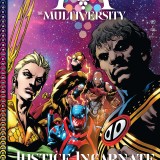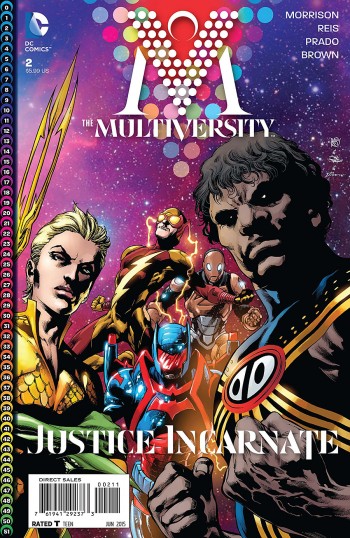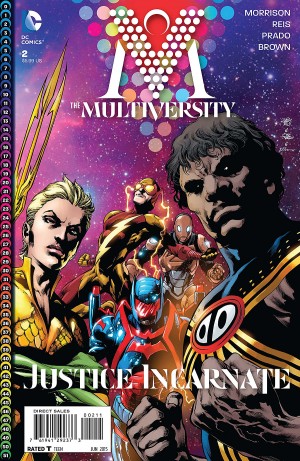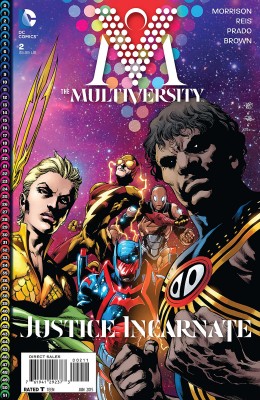
COMIC BOOK REVIEW: The Multiversity #2 – The Never-Ending Story
Grant Morrison shows the comics industry why he is one of the greatest comic writers EVER! Riding high on the recent 2015 Eisner’s nomination, his superhero epic saga THE MULTIVERSITY puts him again in serious contention with some of the best of the best in the industry, and what better way to exhibit his aura […]
Grant Morrison shows the comics industry why he is one of the greatest comic writers EVER! Riding high on the recent 2015 Eisner’s nomination, his superhero epic saga THE MULTIVERSITY puts him again in serious contention with some of the best of the best in the industry, and what better way to exhibit his aura of nigh-absoluteness by looking on the finale of what considered being his greatest superhero magnum opus, The Multiversity #2, Superjudge.
Reviewing Morrison is no walk in the park. He’s simply formidable to begin with. And The Multiversity #2 illuminates the challenges of digesting, interpreting, comprehending, and conceptualizing what exactly he wants to convey in this mind-bending and thought provoking postmodern piece of visual literature. Simply put, it’s engaging for most of the issue.
Despite being delayed for more than a month or so (The Multiversity #2 was solicited for March 2015, but typical Grant Morrison, expect delays) and a bit hefty priced, this closing chapter has all of the things synonymous/connected/associated/related to Morrison. Non-linear and/or cyclical storytelling modes are in place that showcasing the battles in different universes within the DC Multiverse against the malevolent forces who want to destroy or refashion the existing status quo to their likings. Superheroes and their counterparts/amalgams in most Earths (13, 43, 18, 17, 51, 20, 36, 26, 48, 8, 29, 23, 36, 19, 11, 23, and 7 [and 0 in typical Grant Morrison fashion.) must deal with the constant threats and near annihilations that extraordinaire artist Ivan Reis showcases his love to the superhero genre, particularly during tense and intense engagements. I just love Reis’s artistic take on one of the most iconic DC demons, Etrigan, in addition to Morrison’s witty and funny dialogues on characterizing this seldom used but interesting character. This is also true in the exchanges between the vampire-versions of Wonder Woman and Batman where they reference various coffee recipes/types! Furthermore, Captain Carrot’s moments are even worth mentioning that only Morrison can deliver, particularly the head scenes! And, the beautifully drawn cybernetic horses in Earth-18 clearly elaborate the tight collaborative effort between Grant and Ivan, fusing the mundane and the sophisticated approaches that only the premier Scottish comic scribe can do.
There are a number of splash pages Reis expertly crafted and then, divided into panels or multiple squares to present the faux-three dimensional (3D) feel of the impact the omnipotent-level beings are doing in destroying the multiple realities, and the convoluted perspectives needed to illuminate the almost sense of desperation that eventually make a heroic stand/move to avert the supposed inevitability (the nod to the Crisis of Infinite Earths Flash-Barry Allen heroic moment). In other words, these panels are used for maximum effects of the bending time and space continuum experience.
Twisting the trivial is another of Grant’s hallmark fingerprinting and uncanny creativity. The mark of the beast is eschewed with the simple reserve and named Hellmachine that challenges the secular and corporeal essences of the supposed religious forms and substances. Its Legion can be a minor character study because the multiplicity of the singularity of the name itself that connects to the avatar of villainy or the “otherness”. Moreover, this is even more telling in the numerous presentations of the cosmic version of the Rubik Cube that symbolizes of the simplicity of life at the same time, the complexity of maintaining order in the midst of chaos and annihilation. Nix Uotan’s representation of the omnipotence is also the subject of vulnerability of anything associated with humanity by being corrupted and possessed. And the Gentry’s symbolic Illuminati imagery satisfies the supposed all-controlling and seeing existential instrumentality which dominates our illusionary but conscious desires of anything but lead to nothingness. This single issue alone and the entire series itself can be a serious philosophical and deconstructive academic thesis on the multiple signifying signifiers. Go figure!
Additionally, word associations and creativity, and the emphases of the words in dialogues are highlighted even so. Notice on the numerous enlargement of terms/words/phrases/fragments that seem obvious, but significantly more blurring than ever. This is more complicated in Grant’s word/term connotations that demand multiple readings to comprehend the magnitude of the entire Multiversity saga. For instances, the “gentrification” and “retaliators” can be meant of belongingness/subjugation and chargers, respectively. Yet, classical structuralism is merely a shadow of the direct definitions in Grant’s deconstructive schema. There are layers indeed, but not in the literal sense, similar to the divisions of panels of a supposed single splash page. In addition, the size of the numerous lettering signifies the power-levels of the characters involved and/or the urgency of the task needed to accomplish which eventually blends to the typical superhero genre. And the names Operation Justice Incarnate and Ornery of Worlds give credence and bewilderment of the potentialities of the realization of the existence of the multiversity itself, more so with the counterparts and the formation of the superhero team of epic proportion against the nameless (but supposed omniscient and omnipotent) devil-like figure. The term “justice” is consistent to other similar/parallel teams in other DC universes to coincide the unity of bringing order and maintaining its existence with the abstract but clear notion of justice.
And the usual breaking-the-fourth-wall moments are way too obvious to begin with. Yet, the utilization of the single-issue and standalone Multiversity copies presents a unique illumination of storytelling that only Grant Morrison can deliver. This is a way of saying rubbish to those who still believe the antiquated notion that comics are just base, childish, and low level form of entertainment. These standalones are regarded as instruments of the forces of good and evil, the yin and yang of stuffs depending on the users themselves. Technically all of these issues should be mentioned or highlighted, but only the Guidebook, The Just, and Ultra Comics Society of Super-Heroes are deemed significant in the overall cyclical approach of storytelling.
So, so much for the convoluted and meta-analysis of this sure winning comic event series, but nothing is perfect. First, the last splash page suffers some artistic inconsistencies, particularly the faces of the superheroes of virtually all universes. Despite the fact that Reis is one of the few highly consistent artists around, he is no George Perez in the illustrations of numerous superhero characters in one-entire page. And, where are the characters of the Paz Americana issue? Does that mean that its universe is one of two destroyed (Earth-7 is the other one)? And, to fully benefit of enjoying The Multiversity, all of its issues should be read (and reread) to make sense a bit. This finale is not your typical superhero smack down finale moment. Speaking of which, there was no fight scene or a serious smack down challenge to the nameless “demon”-mastermind, even so with Nix Uotan himself! What are circumstances behind these obvious neglects? My guess is as good as yours! Lastly, I personally feel the underwhelming finish due to the fact that the mentions of “an endless event”, “final chapter of your never-ending story” and “oblivion machine” are definitely themed as cyclical, and the possibility of another Grant Morrison superhero mega-postmodern event in the horizon or so (the possibility is high IF he wins one of the many nominations in Eisner’s and other comic-award giving bodies). I was rejoiced in the ending of All-Star Superman. I was intrigued more on the image of Bruce Wayne in Final Crisis. I was engaged with the announcement of the Batman Incorporation in Batman and Robin. I felt the sense of justice in the last page of We3. I wanted to be part of the nothingness in the final pages of his Invisible issue. But here, I am satisfied but not sate enough, almost a near “meh” moment until I realized the first chapter of this event.
The Multiversity #2 virtually neatly finishes (apparently) what needs to be done. The possibility of another Grant Morrison saga is a big theoretical one, not hypothetical. Though some glitches are apparent if scrutinized closely, nevertheless it shows how an event should be ([coughing] Convergence). Grant Morrison indeed deserves the Rock God of Comics status!



















